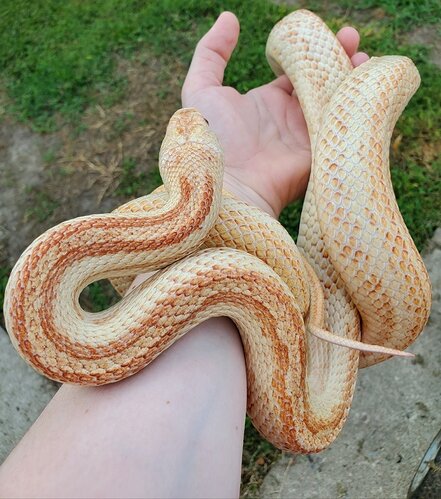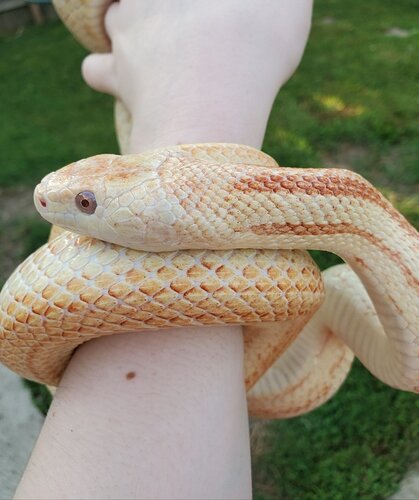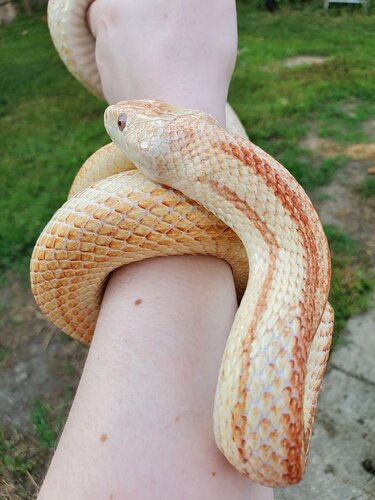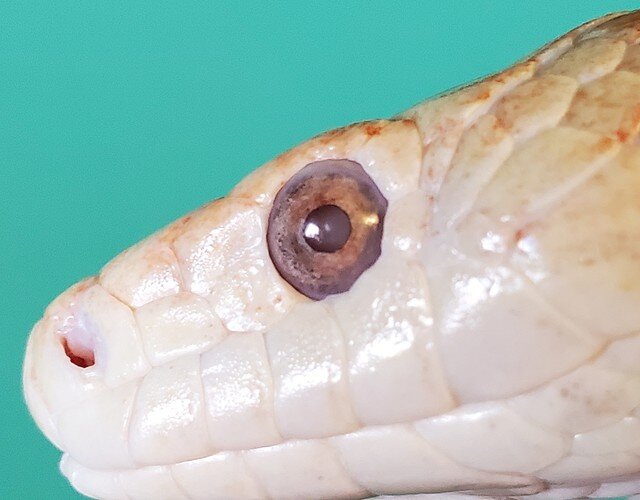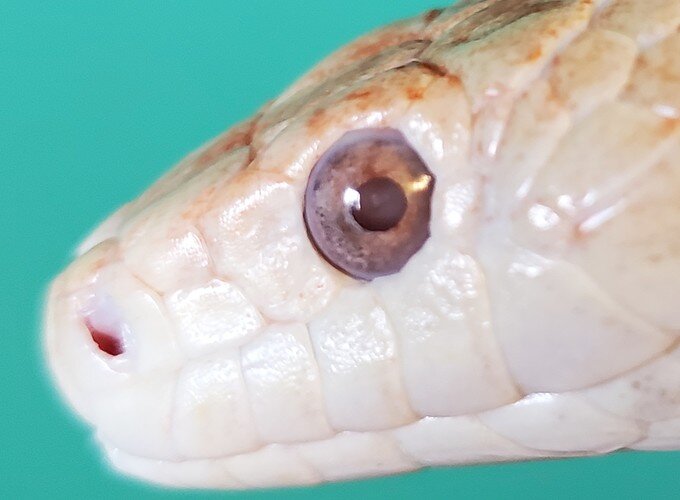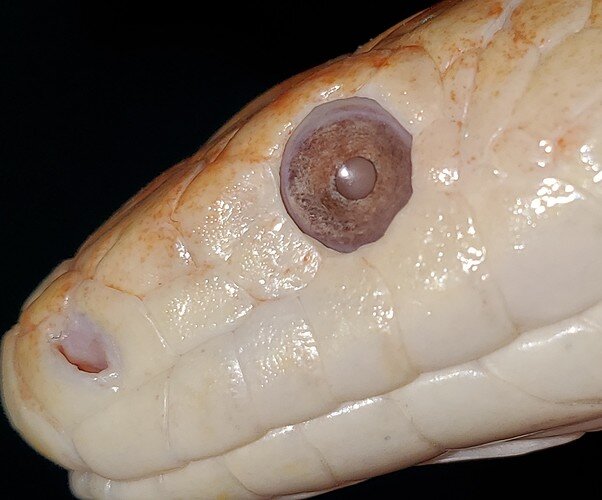So, got word from the vet earlier and the meds I was giving her are what the bacteria in her lung is weak to. There are 2 types of bacteria which is probably why it was getting worse for a bit as it just takes longer for the antibiotics to work. The vet said for me to start her back on the others, and I will be getting some antibiotics for a nebulization chamber in a couple days as well.
Gave her the first round of nebulization chamber treatment today, and will be giving her them for 21 days everyday. I also gave her another shot, and cleaned her cage. Even after all that she still ate just fine. She definitely isn’t one to get stressed or scared. Then again if I was 6’1" I probably wouldn’t either. 
I’m glad she’s still eating good still. I’m sure she’ll pull through just fine 
Just a little update. Here she is in her nebulization chamber. It is extra steamy in there since I finally got a really good seal on the lid.
I just want to say that I applaud that you are caring for her so diligently and willing to work with a vet. I realize it can be very expensive and time-consuming.
You know in Peter Pan, when you have to clap your hands to make Tinkerbell live, because you believe in fairies? Taking a vet’s recommendation is just like that- it makes us feel validated and helpful, it helps us go on. The majority of people have major cost limitations, and it’s hard for vets to see our patients decline when it would possible to intervene in some way. I absolutely understand the practical limitations that come up with paying veterinary fees, I don’t mean to imply that everyone should blindly follow their vet’s advice. I’m just saying that, when it happens that an owner is willing to go forward with what I really think is best, it is always a joyful and gratifying feeling. Like a weight taken off my shoulders, knowing that I’m able to do the very best I can.
Quick update on Polaris. For the past week or so it seemed like she was getting worse, and I thought I was going to have to take her in for more testing. She was puffing more, and pretty inactive. Turns out she just took like a full week to shed. The shedding+the dried mucus must have been what was making it harder for her to breathe. She isn’t even holding her mouth all slanted anymore and isn’t puffing.
Her damaged eye cap that was making it hard for her to see out of her left eye is also cleared up from this shed, and her few scars (either from rat bites or sharp bedding) look better too. She ate a jumbo mouse with no issue for me tonight as well. Still probably going to do another round of meds to make sure she is recovered completely though. I will get some pictures of her tomorrow so y’all can see her after a fresh shed.
Great news! Hopefully she is on the mend…
Here are some pictures of her. She stayed surprisingly still for me when I took these lol.
She is so brightly colored now, and her eye looks great.
Bonus picture of when she got spooked by a dog bark and whipped her head around to look towards it
 .
.
She is looking beautiful
The more I look at her the more amazing she seems. She comfortably has a seat in my list of favourite snakes.
I find myself staring at pictures I have taken of her just admiring how bright her colors are. Eastern rat snakes are my favorite species of snake, and I am glad I was able to get her the care she needed. She is also fun to handle, and will let you pet her on the head and not care in the slightest. If you lived near me I would let you meet her and hold her, but alas, you are in the England.
As of today Polaris is finally off meds, and hasn’t had any sign of illness in a couple weeks. There is still something I am concerned about, but don’t have the money to get another checkup at this time so I am going to keep an eye on things at home. Whenever she overexerts herself you can hear a slight wheeze, but the vet told me that if she had the RI long enough then there is a chance that she could have a wheeze for a while even once recovered. There is a chance she could even have it for the rest of her life. So long as she is healthy and eating then I don’t mind, I mean I wheeze when I overexert myself as well so I know the feeling lol. Now to search for a het albino black rat for her to help figure out if her striping is a recessive gene or not. (Doing het albino because I really want a solid black rat snake  ).
).
I am glad this rough path is apparently over for her and you…hopefully you can get possible gene proved out soon…looking forward to that good news. 

@mblaney Since you are a retired vet I figured I would see if you agree. If you refer to my most recent post it explains that the vets said Polaris could have wheeze for a while, if not permanently even when she is no longer sick. Is this true? I know you aren’t a reptile vet, but don’t see it bad to ask if you have heard of this kind of thing before.
You can always ask! In fact, it makes me feel exceedingly clever, if I happen to know the answer!
Off the cuff, I agree with your vet, but let me check the “Bible” of reptile vet med (Mader’s Reptile Medicine and Surgery), just in case.
So, (not sure why I didn’t think of this), snakes can’t cough- no diaphragm. So exudate in the lungs has to be gradually broken down by the body. So it would make sense that any recovery would be quite prolonged, especially if she came from a place with husbandry such that would lead to an RI, in which she had been housed for awhile. Plus most snakes only have one functional lung, so that probably doesn’t help them out, though that’s not true for all species.
I couldn’t find a lot of specific info about lasting signs after elimination of disease, but what your vet says makes sense to me. Just keep an eye/ear out, to make sure you catch it quickly if symptoms return/wheezing doesn’t slowly improve. You have a sharp eye so I imagine you’d notice something amiss pretty quick.
I have a trick I teach dog/cat owners who have pets dealing with respiratory challenges, I don’t think it would be quite as accurate in reptiles (though still a semi-decent tool- see later).
For mammals, I tell owners to get a clock with a second hand, or use the stopwatch on their smartphone, and to count the number of breaths in 1 minute, with their little buddy at rest, then compare them to the normal values (which I’d tell them).
For a reptile, I am guessing that you’d have to go for a longer amount of time, but that should be fine, so long as you are consistent. So long as you stay consistent with regards to the context and counting method, you should have a moderately accurate tool to mark progress.
Now, the caveat to this is that snakes increase the size of the breaths they take (‘tidal volume’) when under increased oxygen demand. I totally didn’t know that 30 minutes ago.  So, respiratory rate isn’t quite as good a predictor of respiratory health as in a mammal, but if you stay consistent, it should help you gather info at home. Plus, if you present your vet with a log of respiratory rates, should she ever have to go in again, your vet will think you are a supreme badass (or at least they should!).
So, respiratory rate isn’t quite as good a predictor of respiratory health as in a mammal, but if you stay consistent, it should help you gather info at home. Plus, if you present your vet with a log of respiratory rates, should she ever have to go in again, your vet will think you are a supreme badass (or at least they should!). 
I looked around a bit, and a ‘typical’ respiratory rate for snakes doesn’t seem to exist, both because of the variety of species and because context has major affects on reptile respiration. For example, they sometimes hold their breath, rate changes a lot when being handled, etc. But, very very roughly, it seems that many species of snakes tend toward 1-3 breaths per minute, when at rest. 

Figured I would update again, since I am sure some were wondering. Polaris has been doing fine, and seems to be recovered from the RI. She eats just as well as before, but no longer passes her food in two days (diarrhea in snakes). Instead she takes around 2 weeks to pass her food. I still believe I hear the occasional huff from her, but it isn’t like one from an RI and she doesn’t have mucus in her mouth. She also doesn’t hold her mouth open or at a weird angle, so I believe she did just have the RI for a long time and there might be scarring (or something similar) in her lungs. If she shows obvious signs of infection again (diarrhea will be the most obvious thing) then I will take her to the vet to get fecal tests done, as well as get recommendations from the vet. She has also been keeping weight on wonderfully, and hasn’t been losing it quickly like she did when sick.
Many months later, and unfortunately she has still been having medical issues. She has recently finished another two rounds of antibiotics and still has a slight whistling when breathing every so often when exerting herself. I just noticed that something is wrong with her left eye last night as well, and it almost looks like she has a cataract in her eye.
I am unable to afford a lot of vet care for her, so any further testing will have to wait a bit, but I did send pictures to the vet to see what they think of the eye. Here are the pictures for those wanting to see something that I honestly didn’t know snakes could get, assuming it is a cataract.
Luckily her appetite is still as strong as ever, so she is still keeping weight on fine. I wonder if she is a lot older than the breeder said given what seems to be a cataract, as that usually happens in older animals. @mblaney what do you think about her eye? I know you aren’t a herp vet, but you might at least have a better understanding of cataracts than me since they happen in dog/cats as well.
Let me see what I can find in my textbooks, be back in a bit.
So, as I’m reading, I’m finding some useful info, but with ophthalmic conditions, it’s really important to have a thorough eye exam done (at least in mammals), because an ophthalmoscope lets you look inside the eye itself. You can tell if a cataract is present, if stuff is floating in the eye- and which part of the eye, get a look at the retina, etc. Reptile eyes are so small that you really need that magnification to avoid missing lesions. I just feel I need to mention that because pictures offer little information about the eye, and is no substitute for a legit pro doing an eye exam. That said, a reptile vet may or may not feel the need to refer a patient to a veterinary ophthalmologist if the issue is complicated, the treatment is complicated, or they aren’t familiar with the presentation.
But here are random useful tidbits and info:
-I don’t have a snake of my own to compare to, so it might help others if you post pics of the opposite/normal eye. edit: also a pic of her head from above, to compare the silhouette of her two eyes from the top.
-Sub-spectacular abscesses can be caused by a lot of stuff, and the ring around the outside of the eye could conceivably be purulent exudate, but I don’t have the experience to tell. Infection comes via 3 routes: penetrating trauma, ascending infections through the lacrimal duct, from the mouth (sounds most likely, if she has any stomatitis from her illness), or by being spread through the bloodstream (septicemia). With this you’d expect to see a bulging outward and a mostly opaque eye. Pseudomonas is one of the many common agents, but you’d need to do bacterial (aerobic & anaerobic) and fungal cultures to know for sure what caused it.
-cataracts do occur in reptiles, though I guess most often in monitors. However, to my not-exactly-fully-reptile-trained eye, it appears as though the entire eye is affected, not just the lens. A cataract is specifically the lens clouding (just in case anyone reading didn’t know). They can be an aging change or inherited if they occur in a young animal. Cataract removal is possible in reptiles but very rarely done.
-Lenticular sclerosis is a condition that appears in reptiles as well (you see it in dogs a lot too), and that’s a uniform haze to a lens that is often an aging change. Given her age, I think it’s unlikely.
-Exposure to cleaning chemicals, pesticide strips, etc. can all cause keratitis.
-Foreign bodies and bedding abrasions can cause issues, and parasites can too, but I would expect more obvious lesions (maybe?).
-Like anything else with herps, eye issues can be a result of husbandry problems (which I doubt in this case), or a sequela to some other disease process. I think being part of a larger disease process is more likely than husbandry, given that she’s going through an illness and you’re an experienced keeper
-The 3 most common ocular diseases in snakes are retained spectacle, subspectacular abscess, and pseudobuphthalmos (the eye looks like it’s bulging, but in reality it’s something else causing the appearance, e.g. pus).

